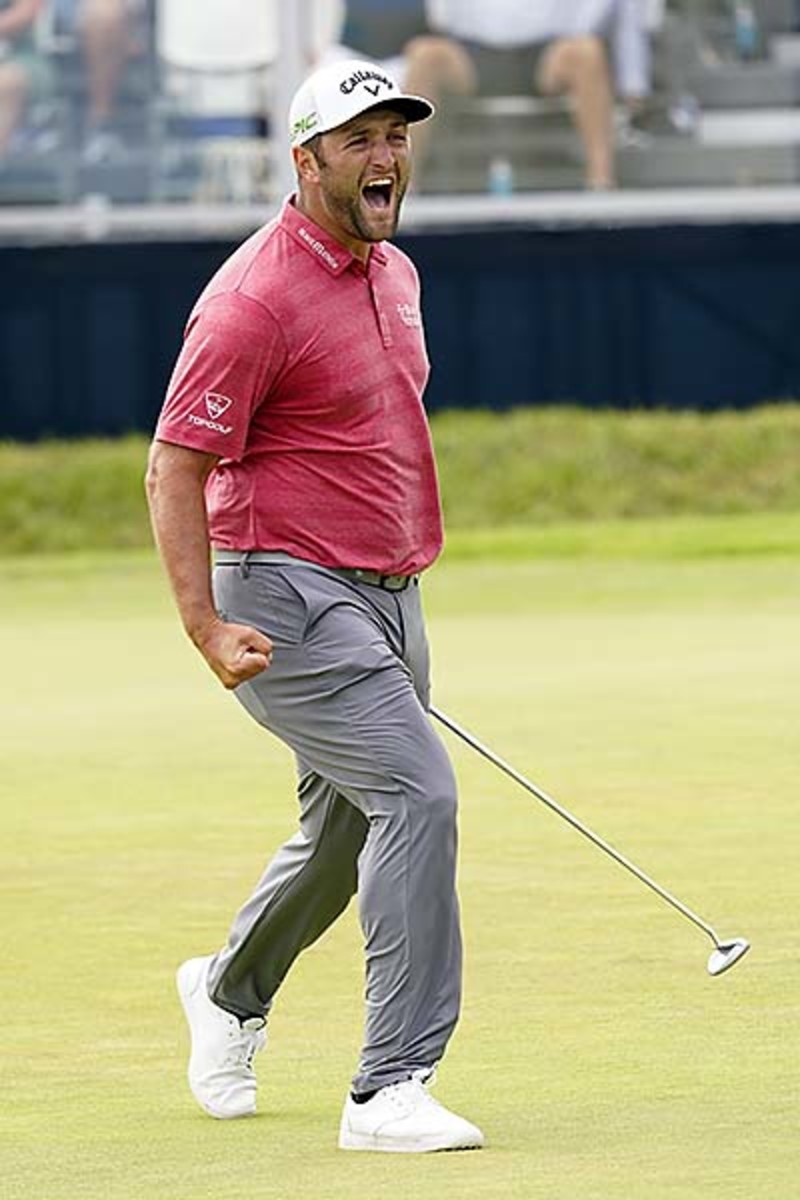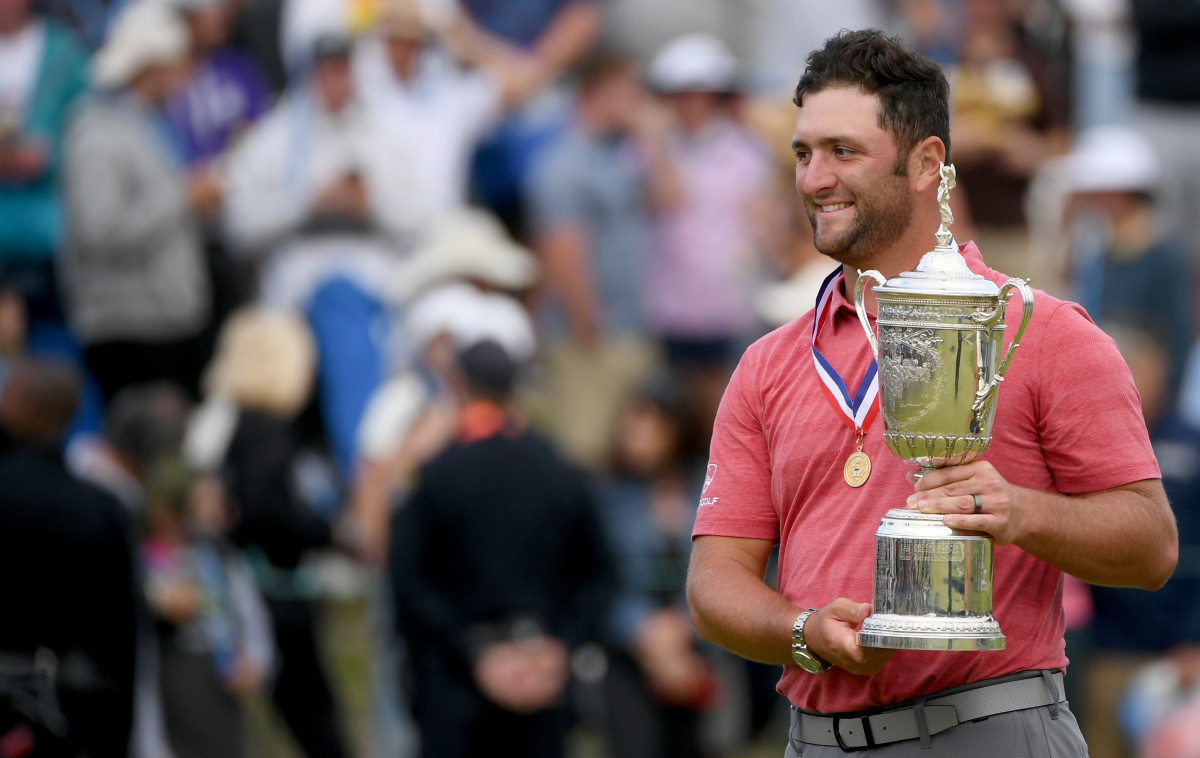Jon Rahm Wins 2021 U.S. Open for First Major Championship Title

Torrey Pines is batting 1.000.
Two U.S. Opens at Torrey Pines’ South Course and two colossal, momentous moments on the 72nd hole.
You can take all the course criticisms, many of them valid, and dispose of them in an environmentally sensitive way, please, by order of the Lords of California.
Thirteen years ago, the sonic boom heard at Torrey’s 18th green occurred when the guy in the red shirt and black slacks poured in a putt to force a playoff. Not Rocco Mediate, that other guy. That Tiger Woods gent. Some have called it the best U.S. Open of all-time. Let’s not quibble. Can’t we all just get along?
Sunday, the roar belonged to Spain’s likable Jon Rahm, dressed in a coral shirt and gray slacks, not Tiger’s mandatory red-and-black. His finish matched Tiger’s, or maybe even exceeded it, because Rahm made hard-breaking left-to-right putts on the 17th and 18th holes to snatch the lead from South Africa’s Louis Oosthuizen and, it turned out, win the Open.
Prepare to read forced prose or headlines such as, “This reign from Spain looks ready to sustain.” Or, “Rahm tests positive—for U.S. Open title.”
Sorry if your favorite golf player tanked in the final round or, perhaps, was simply beaten senseless by Torrey Pines’ South Course. More than a dozen contenders had their eyes seriously on this Open prize and then faded away, sometimes in the blink of a bad shot, of which there were many. The U.S. Open on Sunday does that.
But who could root against Rahm after he had the recent Memorial Tournament all but won with a six-shot lead after 54 holes only to be forced to withdraw because he tested positive for the virus?
This U.S. Open was karmic justice in a way except there’s no such thing as justice in golf. There are only birdies and pars and scores lower than others. Karma doesn’t hole putts, skill does. Rahm, 26, who shot a closing 67 to finish at 278 6-under-par, disagrees.

“I’m a big believer in karma,” Rahm said moments after Oosthuizen finished. “After what happened a few weeks ago, I stayed really positive. I know I got my breakthrough win here, it’s a very special place for my family. I can’t even believe I made those final two putts. I don’t know how to explain it.”
Factor in more karma, if you must. Rahm proposed to his wife, Kelley, on the grounds at Torrey Pines. Sunday, she met him behind the 18th green and handed him his greatest prize, his baby boy, Kepa, two-and-a-half months old. As he walked to the scoring area, Rahm kept kissing his young son on the side of his adorable bald-baby head.
Rahm is now golf’s King of the Hill—with apologies to his mentor, Phil Mickelson, a fellow Arizona State University alum who collected on assorted bets with fellow pros when Rahm first burst onto the tour that Rahm would reach No. 1 within a few years. Mickelson won the PGA Championship in May but he faded on this weekend. Mickelson was seen on the range, sitting with Rahm’s wife while they waited to see if Oosthuizen could eagle the 18th and force a playoff—he couldn’t.
Maybe Mickelson isn’t your favorite player, either, but it was a nice touch by a real friend.
Rahm got his breakthrough PGA Tour victory at Torrey Pines in the Farmers Insurance Open. This place is as lucky for him as it was for Woods, who won eight tournaments at Torrey Pines.
“This place reminds me a lot of back home (in Spain),” Rahm said. “The weather, the coastline. Everything that happens here, I don’t know why but I’m just happy whenever I land in San Diego. We were in our spot and I was able to come out on top.”
Rahm’s final putt was Tiger-esque, a high compliment. His celebration was his own, a big air punch and an undecipherable shout. It was Tiger-worthy, as was his finish, and that putt will be replayed for years. Not quite as often as Tiger’s putt, but you will see it plenty.
Many besides Mickelson have predicted greatness for Rahm. He has already held the world No. 1 ranking, he already had five PGA Tour wins. This sixth victory was even more dramatic, perhaps, than that BMW Championship he won in a playoff with Dustin Johnson by holing a miraculous 66-foot putt. If you don’t recall that one, Mr. Google can help with that.
The tough-luck runner-up was Oosthuizen, one of eight men who had captured the Runner-Up Slam (finishing second in all four major championships). It’s not such a bad thing as long as you’ve won at least one. Oosthuizen took the 2010 Open Championship in a runaway at St. Andrews. (Mr. Google can help you with that one, too, and FYI, how many mentions before Google sends a writer a check? Asking for a friend.)
Oosthuizen also lost a playoff to Bubba Watson in the Masters and, well, he has replaced Mickelson (with his six U.S. Open runner-up finishes) as the poster boy for tough-luck near-misses in majors.

This Open will go down as one of the wildest in modern times. Most of the day, there were at least nine players within two or three shots of the lead. It was anybody’s game—well, anybody who could handle Sunday’s firm greens, treacherous pin placements and the crucible that is Open pressure.
Most of those would-be contenders faded with glorious failures. You need a scorecard to spot the non-winners. (The word, “Losers,” seems harsh and those gents suffered enough on the back nine.) So, here’s your scorecard of who went south at the South Course and how:
Bryson DeChambeau: The Golfing Machine caught a virus, blew a gasket or flat-out did not compute. DeChambeau eased into the solo lead on the front nine with two birdies and extended his streak of bogey-less holes to 30 until trains began to wreck. He bogeyed the 11th hole. Then the 12th. The 13th is a par-5 that the Beast That Is Bryson would surely reach in two, right? No, he gouged his way up the thick right rough like a 12-handicapper, having slipped on his tee shot, deposited his third in a bunker below the green then boned a home run over the green and the gallery and may have clinched the pennant for Cleveland. It was a double-bogey that killed his chances and just to make sure, he dropped a quadruple bogey 8 and shot Hank Aaron—that’s 44—on the back nine. Somehow, he went from the lead on the back nine to 26th place. Wow.
Rory McIlroy. The man trying to end a seven-year major drought crept to within one of the lead, then bogeyed 11 and followed that with an awful bunker-to-bunker-to-greenside-rough stretch that led to a double-bogey at 12. Color him gone.
Russell Henley. You may recall this distant afterthought who began the round tied for the lead. Consecutive bogeys at the sixth, seventh and eighth largely removed him from your television viewing pleasure.
Brooks Koepka. Someone must be impersonating the tough closer who won four majors in three years. Birdies at 13 and 15 lifted him to within one of the lead. At the massive par-3 16th hole, Koepka had a 4-iron in his hands and the kind of clutch iron shot he loves to stick close on Sunday. Instead, he yanked it left of the green and made bogey. At 18, needing a par to tie to the leader in the clubhouse—Harris English, whom most of the contenders passed in reverse—Koepka’s super-flop third shot dropped in a greenside bunker, his bunker shot ran past the hole and he missed the par putt. All right, even if he makes birdie there, it doesn’t matter, as it turned out. But who is this guy and what ever happened to the real Brooks (Book It) Koepka?
Paul Casey. The Englishman famous for coming close in majors did so again, He charged near the lead with three straight birdies starting at the seventh, then promptly bogeyed 11 and doubled 12 to drop back out of the heat.
Collin Morikawa. The 2019 PGA Championship winner made three birdies on the front but doubled the par-5 13th—supposedly a birdie hole—and clinched his irrelevance with another bogey at 15.
Mackenzie Hughes. This Canadian, also tied for the lead after 54 holes, self-destructed with three bogeys on the front nine and suffered a terribly unlucky break. His errant tee shot at the par-3 11th hole bounded off a cart path up into a tree—and stayed there. Cameras showed the ball resting on a branch high up in the tree, penned in by another branch. Somebody ask Rahm what kind of karma that is. How does a Canadian have bad karma? Everybody loves Canadians.
Matthew Wolff, Scottie Scheffler and Xander Schauffele all made brief appearances in contention, too, but watching this Open unfold with a cast bigger than “In the Heights” was exhausting, so let’s move on.
The disasters by so many highly-ranked players were disarming. NBC analyst Paul Azinger best summed it up after McIlroy’s ugly double: “I just said a little while ago that the cream has risen to the top—it looks to me like it’s just soured.”
It’s an oft-used cliché that the only real winner at a U.S. Open is the golf course, whether it’s Oakmont or Winged Foot or, yes, even not-so-highly-regarded Torrey Pines.
Torrey Pines was just that tough on this Sunday. That’s how U.S. Opens are supposed to roll. Rahm rolled better than most. He played the best golf in the toughest conditions and shot the lowest score.
That’s not karma, that’s championship golf.
More Final-Round Coverage From 2021 U.S. Open:
- Rahm wins U.S. Open for First Major Title, by Gary Van Sickle
- How Rahm Finally Learned to Keep His Cool, by Michael Rosenberg
- Daily Question: Which Contender Should Feel Worst About Missed Opportunity?
- How Much Did Luck Play a Role on Sunday? by Alex Miceli
- Phil Mickelson Slumps on Weekend, Now 0-for-30 at U.S. Open, by Mike Purkey
- Mackenzie Hughes Gets Bad Bounce, Worse Break, by Mike Purkey
- Sights and Scenes From Final Round
- Olympic Qualifying Complete, but Top Players Mixed on Participation
